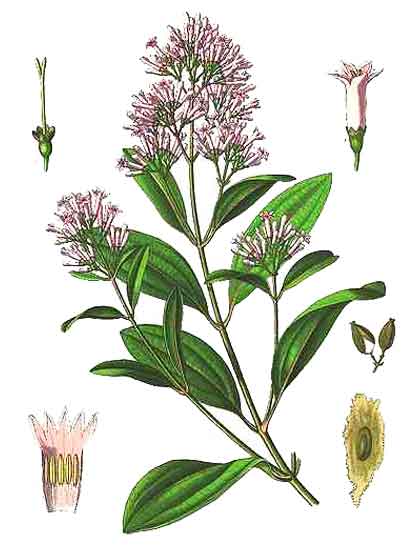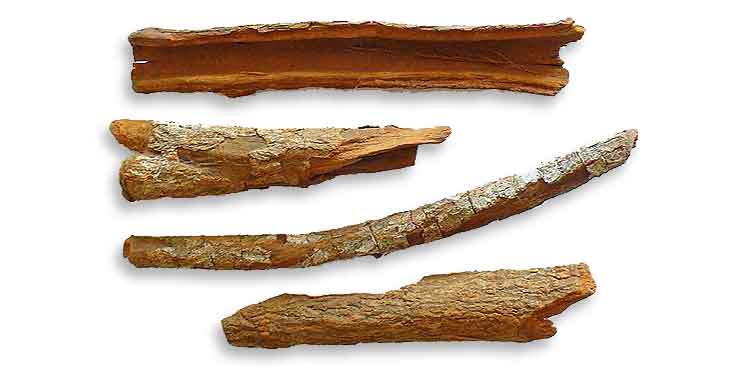 Botany Botany
Cinchona is a small-sized tree. Leaves are opposite, entire, elliptical, and pointed at both ends. Flowers are white or pinkish, occurring in panicles, and have a pleasant odor. Corolla is tubular, 5-lobed, fringed along the edges with long hairs. Fruit is an ovoid or sub cylindrical capsule, with the peculiarity of opening from the base, hanging downward while the valves remain together at the tip. Seeds are numerous, flat, and winged all around.
Distribution
- Thrives best at medium and high elevations in tropical and warm countries.
- In the Philippines, thrives best
in Impalutao (762 meters) and Kaatoan (1,057 to 1,372 meters) in Bukidnon.
Additional info
- Several species of Cinchona have been tried in the Philippines, and after a weeding out of unsuitable species, three have been noted - Cinchona ledgeriana Moens, C. succirubra Pavon, and C. officinalis Linn. For a long time C. ledgeriana has been referred to as C. calisaya Wedd., and is sometimes called C. calisaya var. ledgeriana.
- Some authors consider C. officinalis to apply to a species that naturally grows in the Andes oif southern Ecuador, containing only traces of quinine, or no quinine at all. The cultivated species, C. calisaya, is similar to C. officinalis, but produces significant quantities of quinine. Many authors have used C. officinalis for the cultivated species, and consequently, photos and studies have been misapplied.
- Cinchona tidbit: Cinchona bark harvested from the South American rainforests was a source of commerce for the manufacture of quinine drugs. In the mid-19th century, seeds of C. calisaya and C. pubescens were smuggled out of South America by the British and the Dutch. However, planting and cultivation of the smuggled seeds produced a harvest of low quinine content with no commercial prospect. A more successful venture came from smuggled seeds of Cinchona ledgeriana out of Bolivia, that established extensive plantations of quinine-rich cinchona trees in Java, soon dominating the world production of quinine. By 1918, the Dutch "kina bureau" in Amsterdam controlled the majority of the world's supply of quinine.
Constituents
- About 30 alkaloids have been isolated from the cinchona bark; four are considered important: quinine, cinchonine, quinidine, and cinchonidine.
- Cinchona bark is well-known source of quinine used as a cure for malaria.
-
Philippine totaquina compares favorably with quinine.
Properties
- A bitter tonic for the stomach.
- Considered antiviral, antimalarial, febrifuge, tonic, astringent, stomachic.
- Antimalarial, killing the parasites in the blood, with the exception of those in the reproductive stages.
Parts used
Bark, extract.

Uses
Folkloric
- Used as febrifuge; for neuralgia, influenza and debility.
- Liquid extract used as cure for drunkenness.
- Powdered bark used in tooth powders for its astringency; internally, occasionally useful as a bitter wine creating a sensation warmth, although sometimes known to cause gastric irritation.
- In decoction, used a gargle or throat astringent.
- In Brazil, for centuries the bark of C. calisaya was used for the treatment of malaria.
- In Peru, the bitter bark has been used for fever.
- Used fort diarrhea with bloating, indigestion, and weakness.
- In various traditional systems, used to increase appetite, treat bloating, hemorrhoids, varicose veins, leg cramps, fever, flu, malaria, splenomegaly, to stimulate hair growth.
- Used as homeopathic for neuralgia, impotence, varicosities, gall bladder pains and fevers.
Others
- Used as ingredient in some food items: baked goods, ice cream, condiments, candies and drinks.
- Peruvian bark has been macerated in spirits, sugared and flavored with herbs into a variety of elixirs.
Studies
• Renal Cancer Preventive: Study evaluated the protective role of C. officinalis preventing the carcinogenic effect on the kidney of albino mice induced by heterocyclic amine "mutagen." Results showed CO modulated the carcinogenic effects of the toxic mutagen in the kidneys. Electron microscopy indicated improved cellular organization in mice treated with C. officinalis. (5)
Availability
Wild-crafted.
Bark and extracts in the cybermarket.
Ingredient in lotions, supplements, etc.
|

![]()



 Botany
Botany
